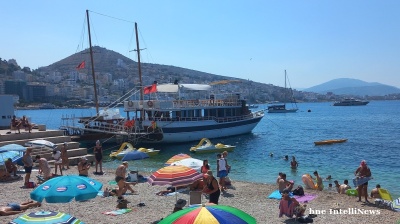Canadian miner McEwen Copper is pushing ahead with one of Latin America's most ambitious copper projects, betting that President Javier Milei's business-friendly reforms will finally unlock Argentina's dormant mining potential.
Argentina, despite its rich mineral deposits, has not produced copper since the closure of the Alumbrera mine, which ran out of ore in 2018. After more than a decade of being stifled by strict currency and capital controls, the country's nascent mining revival is now gathering momentum under Milei's new Large Investment Incentive Regime (RIGI). McEwen Copper's $2.7bn Los Azules project in San Juan province – the eighth largest undeveloped copper deposit in the world – is emerging as a bellwether for the sector's rebirth.
The company has already secured strategic partnerships with European carmaker Stellantis and global mining giant Rio Tinto, which holds a stake through its Nuton subsidiary. Initial operations at the high-altitude Andean site could commence by 2029, potentially producing 175,000 metric tonnes of copper annually – a critical boost to global supply as demand for the vital energy transition metal soars.
In this exclusive interview with bne Intellinews, Michael Meding, McEwen Copper's vice-president, discusses the company's plans to harness Argentina's new investment regime, navigate the country's volatile economy, and produce "green copper" for the global market.
How important was Argentina's new RIGI investment initiative in convincing McEwen Copper to deepen its investment in Los Azules?
Michael Meding: The capital-intensive sector relying on large international investment in Argentina needed an incentive regime like RIGI. Argentina had an attractive mining investment law from the 1990s, but over the decades, it was not always respected by authorities. The RIGI is much clearer regarding individual company rights and investment protection.
It included reduction of corporate tax rates from 35% to 25%, reduction of tax on dividends from 7% to 3.5%, removal of export duties, and faster VAT recovery, important since most VAT is 21%; freedom to import and export, all this in the frame of a thirty year stability. The benefits of the old mining investment law also apply, but you cannot have both benefits overlapping.
What advantages has the RIGI regime brought that McEwen would not have previously experienced in Argentina?
Meding: At McEwen Copper, we believe in Argentina's great potential. We made significant investments even before RIGI because we were confident that something like that would be implemented. For construction financing, RIGI is absolutely required because the amounts involved in mining projects are substantial, and investors need legal stability. We have applied for RIGI in February, the authorities are evaluating our project and we are optimistic about the approval.
Significant copper projects require anywhere from $2.5bn to $5bn or more. McEwen Copper's CapEx estimate from our preliminary assessment published in 2023 is $2.5bn. During the 27-year life of the mine, we have estimated additional sustaining capital for equipment replacement of about $2.2bn. It is a very significant investment over a very long time, so stability is crucial.
What sets Los Azules apart from projects being developed by larger companies like Glencore, BHP, Lundin and First Quantum?
Meding: What I think sets us apart is our environmental stewardship and our focus on building a mine where people thrive and the environment is at the centre of what we do. We believe that having a low water and CO2 footprint is important and can be a future competitive advantage.
Our mineralisation, i.e. the type of copper minerals that nature produced, allows us to use a certain production process that others least economically, may not, and having Rio Tinto through Nuton as a partner, with their primary sulphides technology for copper leaching, sets us apart. This could extend our production timeline beyond the 27-32 years we projected in our preliminary assessment. On top of that, together with Stellantis, we set an ambitious target of becoming carbon neutral by 2038, and we believe this may command a premium for our “green copper” in the market.
Our CapEx will be significantly lower than comparable milling and flotation operations. We already have an agreement with YPF Luz to supply us with renewable power. Additionally, our management team is mostly formed by Argentines with significant experience in San Juan province across all phases from exploration through construction and operation. This allows us to move at a different speed than bigger companies and engage better with the local community.
How do you see Argentina's budding mining sector contributing to the global energy transition?
Meding: Argentina is part of the lithium triangle, along with Bolivia and Chile, and lithium is a very relevant component in any kind of battery for electric vehicles. But copper is equally important, so Argentina already has two potential components for the energy transition. The country also has significant vehicle manufacturing capacity installed – about 500,000 vehicles were produced in 2024, with historical peaks of more than 800,000 vehicles.
It is not unreasonable to think Argentina could play an important role in producing electric vehicles in the future. One advantage of Los Azules is that we will directly produce copper cathodes that can be processed locally, and not copper concentrate that needs to be shipped to China, India, Europe, the US or elsewhere for refinement. Our copper is ready for use in most applications.
What is your current timeline for development at Los Azules?
Meding: We aim to finish the feasibility study by the end of the second quarter this year. After that, we plan to start initial construction activities such as installing an electric line, purchasing equipment, and improving the access roads to the site. Full-scale construction would run through 2027, 2028, and part of 2029.
We have already received our most important permit: the environmental permit for construction and future operation was granted in December last year. Now we need to put together a significant financing package and receive the remaining permits on a timely basis to achieve those targets.
Are you concerned about potential political shifts in Argentina, with elections coming up in 2027?
Meding: During the last elections, all presidential candidates saw mining as the growth engine for Argentina's economic future – something very different from past electoral cycles. There has been a shift in the mindset of Argentinians, expressed in the election of Javier Milei as president. The midterm elections this October for Congress will be a good thermometer to understand where Argentine society is heading. But I believe mining is widely recognised as one of the country's future growth engines. We are optimistic.
How much capital has been raised so far, and how much more will you need?
Meding: In the last three years, we have raised $453mn. We estimate we need to spend another $227mn to reach the decision-making point, and then we have the CapEx of about $2.5bn. When you factor in working capital and other requirements, we are currently estimating $2.7bn to $3bn more to move this project forward. We will publish updated figures as part of the feasibility study.
What role do you see European investors playing in your financing, especially given Stellantis' involvement?
Meding: We have a very interesting but at the same time challenging opportunity given the current geopolitical tensions between Europe, China, the US, and Russia. The European Union needs to ensure sufficient raw material supply for its industry, as not all raw materials can be sourced within Europe. EU investment outside Europe is necessary to secure supply chains.
The days when one could simply buy all raw materials on the open market are over. China already controls a significant part of the copper market through their smelters, as they have about 60% of global smelting capacity. Copper demand is expected to grow from the current 25mn tonnes annually to somewhere between 50mn and over 60mn tonnes by 2050. For perspective, Chile produces about 5.6mn tonnes of copper per year, so we would need the equivalent of seven additional Chiles by 2050 to meet demand. Of course copper recycling will also have a role, but the majority needs to come from new mines.
What pricing assumptions are you using given copper's volatility?
Meding: Copper is called the global economic bellwether: it is basically the temperature indicator of the global economy. In our preliminary assessment, we modelled $3.75 per pound, but we expect to use a higher figure in the feasibility study.
Mining projects in general are often subject to environmental concerns and community protests that may bring mines to a halt. How are you engaging with local communities to avoid such pitfalls?
Meding: The licence to operate is most important, which we believe comes through creation of trust, being close to the community and transparent communication. We have a citizen participation programme in place to communicate about project development, timelines, impacts, and opportunities. In the last three years, we have given presentations to 4,000 people, with sessions lasting two to four hours where people could freely ask questions.
Our management team, including myself, is addressing all community concerns. We also strive to employ as many people from the community as possible, create and support local business opportunities and ask our suppliers to have community programmes and communication plans in place.
How might future US tariffs on copper imports affect your project?
Meding: On the exportation side, we are not necessarily worried because we will be producing copper cathodes, so it depends on where we sell our copper. On the other hand, anything that makes investment goods cost more is obviously a concern. We also have a very early exploration project in the United States, and we understand that the US wants to develop its critical raw materials supply chain.
That could present an opportunity for McEwen Copper with our Elder Creek project. On the other hand, we see that the US is actively pursuing resource independence as we saw with Fast-41, a programme aimed at accelerating infrastructure projects now including mining. This brings additional competition for capital for mining projects outside of the US.
That said, anything causing market uncertainty makes project financing more difficult, and anything increasing costs is unhelpful. We are monitoring the trade tensions between the US and other countries, remaining vigilant and considering different scenarios to achieve the best possible outcome for our shareholders.
Features

CEE needs a new growth model as FDI plunges
wiiw economist Richard Grieveson says the CEE region’s long-standing model of attracting FDI through low labour costs no longer works.
KSE: Ukraine is facing a $53bn budget shortfall, but economy is stable for now
Ukraine is in urgent need of additional financing from partners as the continuation of the war drives up defence spending and reconstruction needs, jeopardizes budget financing, weighs on the balance of payments, and slows economic growth.

PANNIER: Ruling family’s ‘palace in the sky’ cruel sight for Turkmenistan’s poor souls down below
Photos posted of renovated Boeing by US makeover manager offer further insight into "ultra-luxurious" world enjoyed by Berdimuhamedovs.

Russia tax service targets Russian accounts in UAE
The Russian Federal Tax Service (FTS) has ramped up its scrutiny of Russian nationals holding accounts in the United Arab Emirates, following the effective implementation of automatic tax information exchange between the two countries.



.jpeg)